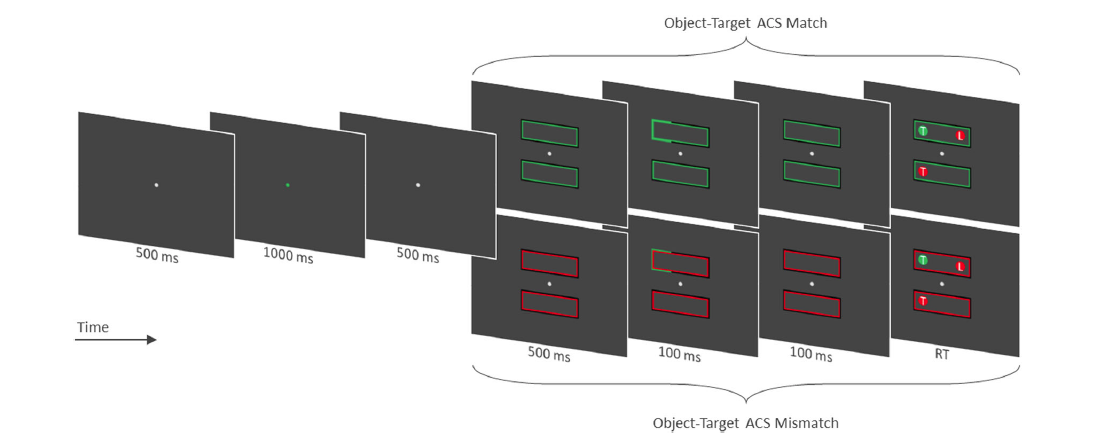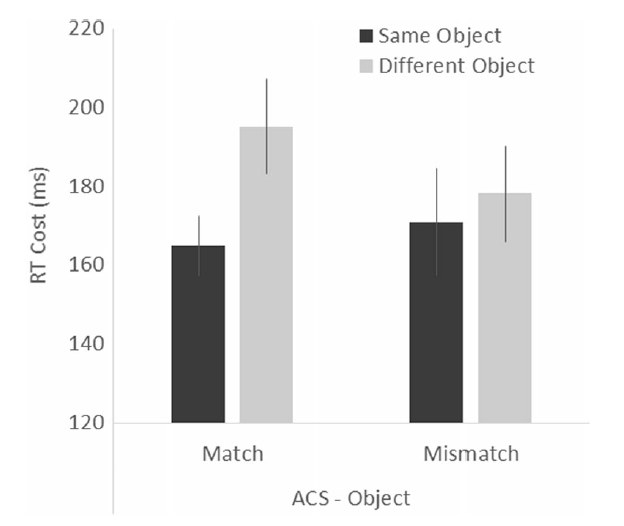Attention guides human perception, memory, and action in intriguing ways. Some time ago on this blog we learned that visual search can be directed by conceptual information: Saying or reading a word such as “tomato” makes it easier to find red things. We also learned on this blog that looking at a tomato can help you touch a fire engine.
One common metaphor for attention is that of a spotlight: our visual attention moves around space, much like a spotlight from a police helicopter can swivel around to focus on areas of interest. On this view, our attention is directed to a location in space, irrespective of what is in that location.
An alternative view of attention is object-based: on that view, our attention is directed not to locations, but to target objects, wherever they may be located in space. Object-based attentional selection is revealed by the fact processing of two features of the same object is easier than processing two features of separate but overlapping objects. This advantage, known as an “object-based effect” or OBE, is observed even when all features are equidistant from the cue, suggesting that visual attention spreads preferentially within an object rather than between them.
However, the boundary conditions of the OBE are still under dispute: for example, it is debated whether object-based attention occurs automatically or is a result of strategic processing.
A recent article in the Psychonomic Society’s journal Attention, Perception, & Psychophysics explored those boundary conditions further. This article won one of the prestigious Clifford T. Morgan Best Article Awards that the Psychonomic Society awarded for 2016.
Researchers Eric Taylor, Jason Rajsic, and Jay Pratt used a method developed to examine “attentional capture”. Attentional capture refers to the seemingly mandatory way in which relevant stimuli capture your attention—for example, if you are monitoring a display for the onset of a stimulus, any light that flashes on the screen will attract your attention without fail. An intriguing subtlety of attentional capture is that the onset of a stimulus will capture attention only if you are looking for appearances of a stimulus. By contrast, if you are looking for a particular color, onset stimuli will be ignored and it is color cues that capture your attention. Taylor and colleagues exploited this finding, that goal-driven attentional control settings can filter out stimuli that otherwise capture attention, to examine whether the OBE might likewise be under strategic control.
The participants’ task was to identify a letter inside a colored circle in the presence of two other circles that also contained letters, but that were identified as distractors by their color. Participants pressed one key when the target was a “T” and another key when it was an “L”. This simple task was embedded in a sequence of other events that manipulated attention and people’s goal before the target appeared. The figure below shows a pair of trials from Taylor and colleagues’ first experiment:

The first event of interest is the green dot presented for 1000 ms (1 second), which signals that the target will be embedded in a green circle. Because the circle was presented centrally, it did not signal a particular location, only the color of the target (with perfect reliability).
The color cue was followed by the display of two rectangles whose color was either compatible with the cue (top row) or not (bottom row). If you look at the figure closely, you will note that the boundary of the rectangles consisted of a thin black line plus another line in the chosen color (red or green). You will also note that for a brief 100 ms (1/10th of a second), parts of the black outline changed to the color of the target in the forthcoming location of the target. That is, although the rectangles themselves were non-informative about the target’s location, that location was briefly highlighted by the change in boundary color. The change in boundary color was predictive of the target location, albeit not perfectly so: On 75% of trials the cue was correct (as in the above figure), and on the remaining 25% the change in boundary color pointed to one of the distractor positions with equal probability.
How can this procedure tells us about the OBE? And how does it examine whether the OBE, if it occurs, is strategically governed?
The first question can be answered by analyzing the two (red) distractor circles in the above figure. Both are an equal distance from the (green) target, but one of them is within the same object (i.e., the same rectangle) whereas the other one is in a different object (i.e., the other rectangle below). Suppose that one of those distractors is now spatially cued (on the minority of trials when the cue was invalid): if the cost of that misleading cue (compared to when it is valid, on the majority of trials) is greater when the cued distractor is in the other rectangle than when it is in the same rectangle, then this would reflect an object-based effect. If being misled within the same object hurts performance less than being misled across objects, surely then attention must be focused not on a spatial location—remember that both distractors are equidistant from the target—but on an object defined by the rectangular boundaries.
The second question, about strategic control, can be answered by considering the overall match between the color cued at the outset, and the color of the intervening rectangles: if people are cued in one color (with the little dot) but are then presented the rectangles in the “wrong” color, chances are that participants might ignore those rectangles to the extent possible so as not get distracted from the target color. If that attentional control kicked in, then the location cue embedded in the “wrong” rectangles might also be ignored and hence no OBE should be observed.
In a nutshell, Taylor and colleagues found an OBE, but only when the objects were compatible with the attentional control set on that trial. The data are shown in the figure below.

The figure plots the cost (in terms of slow-down of the response) that arises when one of the distractors is cued instead of the target. When the color of the rectangles match the attentional set (left-hand pair of bars), that mis-cueing cost is greater when the distractor resides in a different object than when it shares the same rectangle. This represents the classic OBE and shows that attention is preferentially allocated within a defined object rather than being spread diffusely across space.
When the rectangles mismatch the attentional set induced by the initial colored dot, the mis-cueing cost is no longer affected by the identity of the object. Being mis-directed to a distractor slows people down but it no longer matters whether the distractor is in the same or a different object. In other words, the OBE disappeared when the identity of the objects was no longer relevant to the attentional set for that trial.
Taylor and colleagues conclude that “OBEs are not mandatory, and that a participant’s goals mediate the influence of objects on the distribution of attention.” This conclusion was buttressed by two further experiments that modified the above procedure slightly (e.g., by replacing the colored-dot cue with a printed-word cue to eliminate feature-based priming). The results were the same: An OBE obtained only when people’s attentional set was relevant to the objects being examined.
The results of Taylor and colleagues mesh well with earlier claims in the literature that observers cleverly control their attention to prioritize anything that is perceptually interesting and easily processed. When objects reinforce an attentional set, they are processed as objects and used to guide attention. When objects are incompatible with the attentional set, they are ignored to the extent possible and object-based attentional effects are not observed.
Article focused on in this post:
Taylor, J. E. T., Rajsic, J. & Pratt, J. (2016). Object-based selection is contingent on attentional control settings. Attention, Perception, & Psychophysics, 78, 999-995. DOI: 10.3758/s13414-016-1074-y
(Winner, 2016 Clifford T. Morgan Best Article Award).

2 Comments